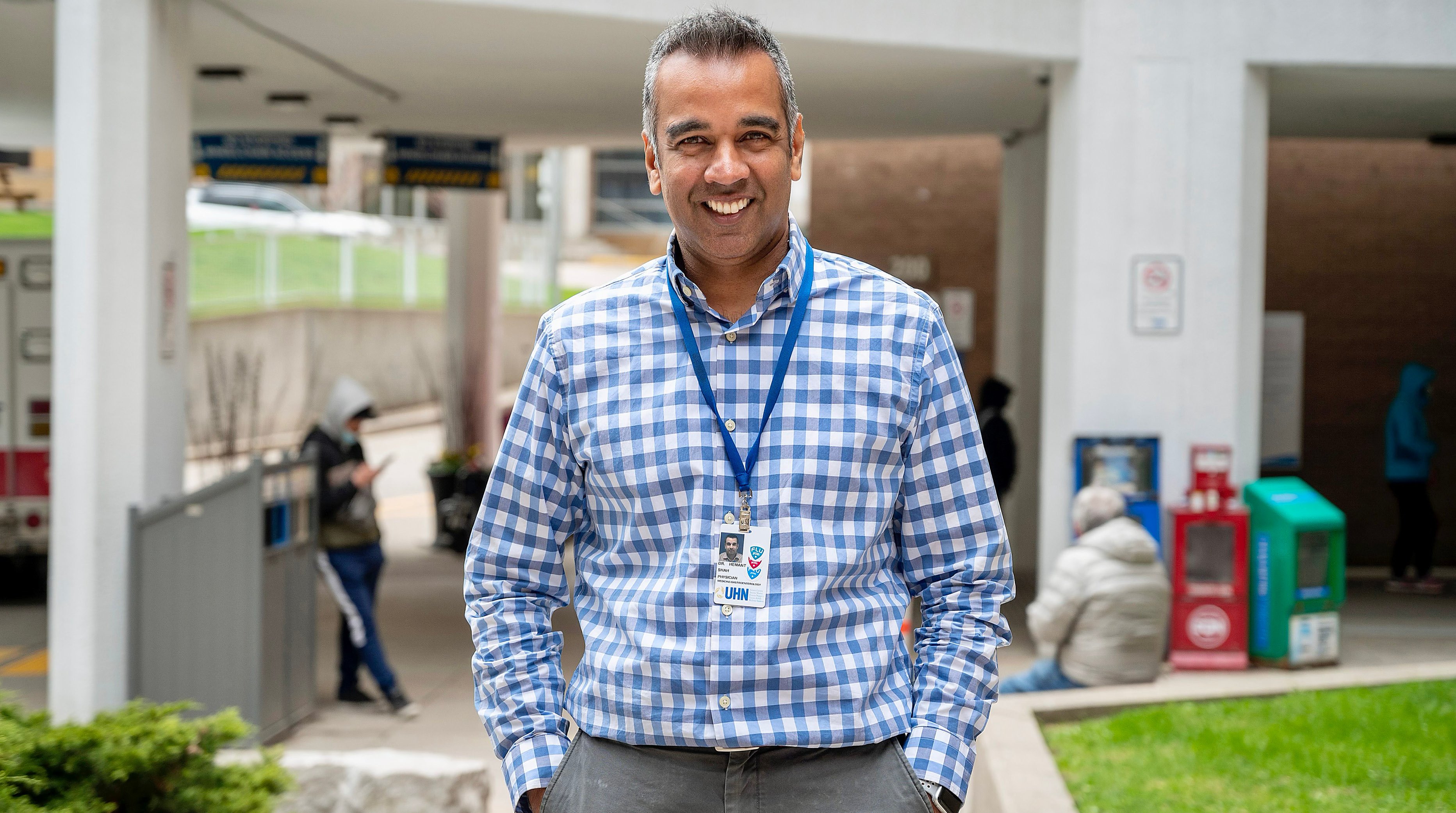This article originally appeared in the Summer 2022 issue of the Ontario Medical Review magazine.
Physicians agree that virtual care needs to be balanced with in-person visits.
F amily physician Dr. Stephen Cooper travels many hours each week to see patients in small communities near his home clinic in Little Current on Manitoulin Island. He enjoys connecting with his patients in person, but he’s also happy that virtual care is making life easier for some of them.
amily physician Dr. Stephen Cooper travels many hours each week to see patients in small communities near his home clinic in Little Current on Manitoulin Island. He enjoys connecting with his patients in person, but he’s also happy that virtual care is making life easier for some of them.
Dr. Cooper’s practice gives patients a choice of whether to meet in-person or virtually, and 70 to 80 per cent choose in-person visits. But for some – including those who need attention in between his clinic visits in smaller communities – virtual care has been a huge benefit.
Dr. Cooper is one of many Ontario physicians who welcome provisions in the new Physician Services Agreement stipulating that all appropriate medical services that can be safely and effectively delivered virtually will be eligible for payment when provided by phone or video. The agreement, ratified in March, replaces temporary billing codes that were negotiated by the Ontario Medical Association on behalf of members during the pandemic.
With the agreement, Ontario becomes the first province to make virtual care a permanent, comprehensive and integral component of the fee schedule.
Photo: Dr. Stephen Cooper practices family medicine in Little Current on Manitoulin Island. He gives his patients a choice of whether to meet in-person or virtually.
“From the perspective of doctors and patients, I think virtual care has been a tremendous asset through the pandemic,” said Dr. Hemant Shah, a Toronto hepatologist and vice-chair of the OMA’s Negotiations Task Force. “I think what the pandemic showed us was that we can safely and effectively deliver some kinds of care without an in-person, physical encounter with a patient.”
On March 14, 2020, just after COVID-19 was declared a global pandemic, the Ministry of Health established a small number of temporary fee codes allowing doctors to bill for virtual care. The change was described as temporary and was specifically intended to help prevent the spread of COVID and ensure necessary care could continue. Prior to that, almost all medical services had to be provided in-person to qualify for payment.
“I think throughout the pandemic, Ontario has actually demonstrated tremendous leadership when it came to rapidly adopting payment policies that were informed by good health-care policy,” Dr. Shah said. “I think it speaks to more collaboration happening between our provincial medical association and the government, and frankly, the tremendous amount of expertise within the Ontario Medical Association when it comes to health policy and health policy research.”
Even before the pandemic, there was a recognition that more virtual care was coming, Dr. Cooper said. The pandemic simply accelerated things.
“Physicians, patients, the ministry and other health-care administrators had recognized that virtual care was going to be a part of the future of the health-care system for a variety of reasons,” Dr. Cooper said. “Patient experience being probably the most important, but also availability, access and easier distribution of clinical time.”
Dr. Shah said that as a specialist, virtual care allows him to conduct routine follow-ups with patients from all over the province who would otherwise have to travel hours for an appointment.
“Patients have an innate desire, for the most part, to be seen virtually because it is often felt to be more convenient,” Dr. Shah said. “I think about my own practice. There are some things I can do really well virtually. I can look after a person with a stable chronic disease that’s followed closely with labs and imaging on a virtual basis.”
“Physicians, patients, the ministry and other health-care administrators had recognized that virtual care was going to be a part of the future of the health-care system for a variety of reasons.”
— Dr. Stephen Cooper
The PSA emphasizes the importance of comprehensive care, paying more for care delivered virtually in situations where physicians and patients have an ongoing relationship.
An ongoing relationship is one where a patient has had an in-person appointment with a doctor in the past 24 months or is enrolled with the doctor or a group. Consultations with a specialist referred to by other physicians also initiate this ongoing relationship.
For family physicians with an ongoing relationship with a patient, or a specialist referred to by that physician, virtual care by video is billed the same as an in-person visit, and at 85 per cent if it is done over the phone (with certain psychiatry care delivered by phone paid at 95 per cent).
For virtual care provided outside of an ongoing relationship – such as that provided by a virtual walk-in clinic – payment is much less. The fee is $20 for a medical consultation provided over video and $15 for care provided over the phone.
“That’s because all the evidence shows that the best health care is relationship-based. And that needs to be recognized in a different way than episodic, non-relationship-based care,” Dr. Shah said.
The discount for phone visits was the result of negotiations with the ministry, Dr. Shah said. The rationale from the province was that phone calls require less infrastructure and may be quicker and less complex than either in-person or video visits.
According to the agreement, virtual care can’t be billed if it duplicates an in-person visit. For instance, doctors can’t bill for two visits if they start with a virtual visit, then decide an in-person visit is required.
The PSA says the new fee structure is the next step in integrating virtual care, and it is up to physicians to use their professional judgment, best evidence and available clinical guidelines about when it is appropriate. The agreement also encourages physicians in certain enrolment-based primary care models to provide about 60 per cent of visits in person, although this clearly may vary depending on many factors.
However, there may be situations that don’t fit the current negotiated model and those circumstances are currently under review.
“I think what the pandemic showed us was that we can safely and effectively deliver some kinds of care without an in-person, physical encounter with a patient.” — Dr. Hemant Shah
Dr. Shah said he expects that as time goes on, regulators and medical associations will start to create guidelines for when, and how much, virtual care should be offered.
“But in the absence of that, it’s going to come down to the professional judgment of individual physicians who set out to deliver the best possible care to their patient and have a duty to do that,” he said.
Sometimes, that can mean convincing patients that they really do need to come in for an appointment.
 Dr. Shah had a patient with a long-standing auto-immune liver disease who started gaining weight at the beginning of the pandemic. When the weight gain continued, he urged the patient to drive three hours for an in-person visit. He found that fluid was collecting in the abdominal cavity as the result of liver failure and that there was an infection as well.
Dr. Shah had a patient with a long-standing auto-immune liver disease who started gaining weight at the beginning of the pandemic. When the weight gain continued, he urged the patient to drive three hours for an in-person visit. He found that fluid was collecting in the abdominal cavity as the result of liver failure and that there was an infection as well.
“If it had been left unattended, it could have turned into something serious,” Dr. Shah said.
Dr. Cooper said virtual care has worked very well for both doctors and patients. “From the patients’ perspective, they find it convenient and timely. And physicians actually find the same thing.”
But he warned that virtual care should not be used to replace local doctors practising in rural communities with phone or video visits provided by physicians practising in far-away cities.
Photo: Dr. Hemant Shah is a Toronto hepatologist and vice-chair of the OMA Negotiations Task Force. Dr. Shah believes virtual care has been a tremendous benefit to doctors and patients alike throughout the pandemic.
“Understanding a patient is not just about the patient, it’s about understanding the community they live in. The worry with virtual care is that patients, clinicians and the ministry may start thinking that virtual care is adequate. But by not living in the community and not understanding the community you’re working in ... you’re missing an important part of that health-care system,” he said.
Kurt Kleiner is a Toronto-based writer.